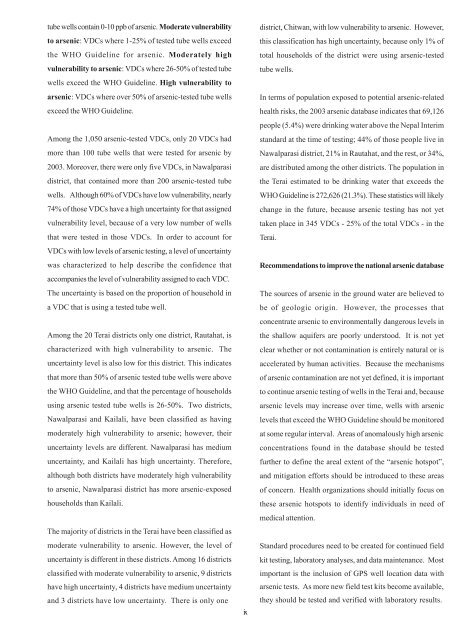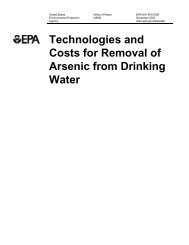The State of Arsenic in Nepal - 2003 - Harvard University ...
The State of Arsenic in Nepal - 2003 - Harvard University ...
The State of Arsenic in Nepal - 2003 - Harvard University ...
You also want an ePaper? Increase the reach of your titles
YUMPU automatically turns print PDFs into web optimized ePapers that Google loves.
tube wells conta<strong>in</strong> 0-10 ppb <strong>of</strong> arsenic. Moderate vulnerability<br />
to arsenic: VDCs where 1-25% <strong>of</strong> tested tube wells exceed<br />
the WHO Guidel<strong>in</strong>e for arsenic. Moderately high<br />
vulnerability to arsenic: VDCs where 26-50% <strong>of</strong> tested tube<br />
wells exceed the WHO Guidel<strong>in</strong>e. High vulnerability to<br />
arsenic: VDCs where over 50% <strong>of</strong> arsenic-tested tube wells<br />
exceed the WHO Guidel<strong>in</strong>e.<br />
Among the 1,050 arsenic-tested VDCs, only 20 VDCs had<br />
more than 100 tube wells that were tested for arsenic by<br />
<strong>2003</strong>. Moreover, there were only five VDCs, <strong>in</strong> Nawalparasi<br />
district, that conta<strong>in</strong>ed more than 200 arsenic-tested tube<br />
wells. Although 60% <strong>of</strong> VDCs have low vulnerability, nearly<br />
74% <strong>of</strong> those VDCs have a high uncerta<strong>in</strong>ty for that assigned<br />
vulnerability level, because <strong>of</strong> a very low number <strong>of</strong> wells<br />
that were tested <strong>in</strong> those VDCs. In order to account for<br />
VDCs with low levels <strong>of</strong> arsenic test<strong>in</strong>g, a level <strong>of</strong> uncerta<strong>in</strong>ty<br />
was characterized to help describe the confidence that<br />
accompanies the level <strong>of</strong> vulnerability assigned to each VDC.<br />
<strong>The</strong> uncerta<strong>in</strong>ty is based on the proportion <strong>of</strong> household <strong>in</strong><br />
a VDC that is us<strong>in</strong>g a tested tube well.<br />
Among the 20 Terai districts only one district, Rautahat, is<br />
characterized with high vulnerability to arsenic. <strong>The</strong><br />
uncerta<strong>in</strong>ty level is also low for this district. This <strong>in</strong>dicates<br />
that more than 50% <strong>of</strong> arsenic tested tube wells were above<br />
the WHO Guidel<strong>in</strong>e, and that the percentage <strong>of</strong> households<br />
us<strong>in</strong>g arsenic tested tube wells is 26-50%. Two districts,<br />
Nawalparasi and Kailali, have been classified as hav<strong>in</strong>g<br />
moderately high vulnerability to arsenic; however, their<br />
uncerta<strong>in</strong>ty levels are different. Nawalparasi has medium<br />
uncerta<strong>in</strong>ty, and Kailali has high uncerta<strong>in</strong>ty. <strong>The</strong>refore,<br />
although both districts have moderately high vulnerability<br />
to arsenic, Nawalparasi district has more arsenic-exposed<br />
households than Kailali.<br />
<strong>The</strong> majority <strong>of</strong> districts <strong>in</strong> the Terai have been classified as<br />
moderate vulnerability to arsenic. However, the level <strong>of</strong><br />
uncerta<strong>in</strong>ty is different <strong>in</strong> these districts. Among 16 districts<br />
classified with moderate vulnerability to arsenic, 9 districts<br />
have high uncerta<strong>in</strong>ty, 4 districts have medium uncerta<strong>in</strong>ty<br />
and 3 districts have low uncerta<strong>in</strong>ty. <strong>The</strong>re is only one<br />
ix<br />
district, Chitwan, with low vulnerability to arsenic. However,<br />
this classification has high uncerta<strong>in</strong>ty, because only 1% <strong>of</strong><br />
total households <strong>of</strong> the district were us<strong>in</strong>g arsenic-tested<br />
tube wells.<br />
In terms <strong>of</strong> population exposed to potential arsenic-related<br />
health risks, the <strong>2003</strong> arsenic database <strong>in</strong>dicates that 69,126<br />
people (5.4%) were dr<strong>in</strong>k<strong>in</strong>g water above the <strong>Nepal</strong> Interim<br />
standard at the time <strong>of</strong> test<strong>in</strong>g; 44% <strong>of</strong> those people live <strong>in</strong><br />
Nawalparasi district, 21% <strong>in</strong> Rautahat, and the rest, or 34%,<br />
are distributed among the other districts. <strong>The</strong> population <strong>in</strong><br />
the Terai estimated to be dr<strong>in</strong>k<strong>in</strong>g water that exceeds the<br />
WHO Guidel<strong>in</strong>e is 272,626 (21.3%). <strong>The</strong>se statistics will likely<br />
change <strong>in</strong> the future, because arsenic test<strong>in</strong>g has not yet<br />
taken place <strong>in</strong> 345 VDCs - 25% <strong>of</strong> the total VDCs - <strong>in</strong> the<br />
Terai.<br />
Recommendations to improve the national arsenic database<br />
<strong>The</strong> sources <strong>of</strong> arsenic <strong>in</strong> the ground water are believed to<br />
be <strong>of</strong> geologic orig<strong>in</strong>. However, the processes that<br />
concentrate arsenic to environmentally dangerous levels <strong>in</strong><br />
the shallow aquifers are poorly understood. It is not yet<br />
clear whether or not contam<strong>in</strong>ation is entirely natural or is<br />
accelerated by human activities. Because the mechanisms<br />
<strong>of</strong> arsenic contam<strong>in</strong>ation are not yet def<strong>in</strong>ed, it is important<br />
to cont<strong>in</strong>ue arsenic test<strong>in</strong>g <strong>of</strong> wells <strong>in</strong> the Terai and, because<br />
arsenic levels may <strong>in</strong>crease over time, wells with arsenic<br />
levels that exceed the WHO Guidel<strong>in</strong>e should be monitored<br />
at some regular <strong>in</strong>terval. Areas <strong>of</strong> anomalously high arsenic<br />
concentrations found <strong>in</strong> the database should be tested<br />
further to def<strong>in</strong>e the areal extent <strong>of</strong> the “arsenic hotspot”,<br />
and mitigation efforts should be <strong>in</strong>troduced to these areas<br />
<strong>of</strong> concern. Health organizations should <strong>in</strong>itially focus on<br />
these arsenic hotspots to identify <strong>in</strong>dividuals <strong>in</strong> need <strong>of</strong><br />
medical attention.<br />
Standard procedures need to be created for cont<strong>in</strong>ued field<br />
kit test<strong>in</strong>g, laboratory analyses, and data ma<strong>in</strong>tenance. Most<br />
important is the <strong>in</strong>clusion <strong>of</strong> GPS well location data with<br />
arsenic tests. As more new field test kits become available,<br />
they should be tested and verified with laboratory results.

















